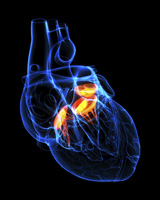 St. Luke’s has always been at the forefront of echocardiography. Our primary goal is to provide superior noninvasive echocardiography imaging and clinical interpretation for patient care. Our laboratory serves as an all-inclusive clinical, teaching and research facility. We offer the full range of standardized and newer echocardiography techniques.
St. Luke’s has always been at the forefront of echocardiography. Our primary goal is to provide superior noninvasive echocardiography imaging and clinical interpretation for patient care. Our laboratory serves as an all-inclusive clinical, teaching and research facility. We offer the full range of standardized and newer echocardiography techniques.
In 1997, the St. Luke’s laboratory became the first in Texas to be accredited by ICAEL, the Intersocietal Commission for the Accreditation of Echocardiography Laboratories. The lab was successfully re-accredited in 2000, and again in 2003.
St. Luke’s is also the unofficial home of the Greater Houston Echocardiography Society. We maintain strong ties with several neighboring academic laboratories within the Texas Medical Center.
Our Medical & Technical Staff
Echocardiography quality is dependent upon the training level and ongoing experience and education of the medical and technical staff.
All St. Luke’s Episcopal Hospital Echocardiography Laboratory medical staff members are board-certified cardiologists with Level III training in echocardiography. Level III is the highest level of training.
Our technical staff is made up of seasoned, registered sonographers, and registered cardiovascular nurses provide care during conscious sedation and stress procedures.
What is Echocardiography?
Echocardiography is the study of the structure and motion of the heart through an ultrasound. Started in 1953, echocardiography has fundamentally changed and improved patient care. A rapidly evolving technology, it has become a fundamental tool for cardiologists.
An echocardiogram, or “echo,” is a painless, portable procedure that can be performed in a physician’s office or the hospital. It can be quickly used in routine and emergency situations, as well as in outpatient appointments.
When the ultrasound waves pass through the chest wall, the procedure is called a surface echo. A transesophageal echo consists of ultrasound waves passing through the esophagus.
Echocardiography provides an accurate assessment of blood flow through the major vessels, heart chambers and heart valves.
In most circumstances, echocardiography examinations have replaced invasive procedures for the diagnosis or monitoring of heart valve disease, congenital heart disease, congestive heart failure and coronary artery disease.
Echocardiography is extremely safe. There are no known risks from the clinical use of ultrasound during this type of testing.
(Top)
Services We Provide
You may hear physicians discussing these procedures directly with attending medical staff
- Transthoracic Echocardiography
- Two-dimensional and Doppler (comprehensive anatomical and hemodynamic evaluation of all cardiac structures — the most common exam)
- Limited two-dimensional or limited Doppler (for specific follow up indications only)
- Echocardiography-guided pericardiocentesis
- Echocardiography-guided endomyocardial biopsy
- Stress Echocardiography
- Treadmill stress echo
- Dobutamine stress echo
- Bicycle stress echo
- Transesophageal Echocardiography (TEE)
- Inpatient TEE (in lab, ICU’s, cath lab, emergency department)
- Outpatient TEE
- Intraoperative TEE (assess complex surgeries of the heart or aorta before and immediately after repair). We are one of a few labs offering comprehensive service in this area.
- Electrical Cardioversion of atrial fibrillation or atrial flutter immediately after TEE.
- Catheterization Lab—guidance imaging of special procedures, including percutaneous device closure of atrial septal defects and patent foramen ovale.
Special Techniques We Use
- IV Saline Contrast – To assess for intracardiac shunts
- IV Saline Contrast – To assess for intrapulmonic shunts
- Lower Extremity (IVC) Saline Contrast – To assess for occult Patent Foramen Ovale shunt.
- Tilt Table TEE or TTE IV Saline Contrast & Pulse Oximetry (orthdeoxia / platypnea assessment)
- IV Microsphere Echocardiography Contrast Agent – To improve endocardial border definition
- Respirometry (tamponade / constrictive physiology)
- Provocative maneuvers for dynamic obstruction (amyl nitrate inhalation, Valsalva maneuver)
- A-V Delay “Optimization” post pacemaker implantation.
(Top)
Equipment We Use
A wide-range of “state of the art” products ensures our staff access to emerging technologies and well-rounded training.
- Philips iE33 (3-dimensional ultrasound) new 2005
- General Electric Vivid 7 Dimension with workstation (3-dimensional ultrasound) new 2005
- Siemens Sequoia Ultrasound Machines
- Philips HP 5500 Ultrasound Machines
- Heart Lab Digital Echocardiography PACS system, new 2005
- Digisonics off-line Analysis system
- SonoSite hand-held portable ultrasound machine
- General Electric Vivid 7’s (intraoperatinve TEE)